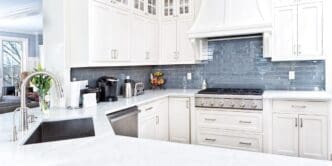Interior designers have shared their insights on kitchen trends for 2025, marking a shift from the stark aesthetics of previous years.
Expect vibrant and colorful backsplashes to make a statement in kitchens. According to Courtney Wollersheim from FLOOR360, hues like deep green or terracotta will complement neutral walls and cabinets. Despite appearing as a bold choice, these backsplashes offer versatility and can be updated as preferences change.
There is also a noticeable trend of blending modern and vintage elements. Homeowners are increasingly looking to personalize their kitchens by mixing contemporary finishes with antique finds, such as vintage plates or flea market treasures. This combination adds character and warmth, allowing for creative expression.
The concept of secondary kitchens is gaining traction. Sarah Pickard of Pickard Design Studio notes that more homeowners, particularly millennials, are reverting to designs reminiscent of past generations. These additional spaces, like butler’s pantries, serve functional purposes such as prep areas or storage for dishes, enhancing both luxury and practicality.
Nature-inspired designs are set to rise, driven by sustainability and a biophilic approach. Deana Duffek of Pure Design House highlights the use of natural materials like wood and stone, alongside earthy colors like sage and terracotta. Kitchens are increasingly incorporating indoor plants and herb gardens, with a growing preference for eco-friendly, reclaimed materials.
Sophisticated lighting technology will play a pivotal role in kitchen design. Joyce Huston from Decorilla anticipates more advanced lighting options that allow customization of color, temperature, and mood, creating a dynamic and personalized space.
Metallic finishes in kitchens are evolving, with a variety of options such as brass or gold being offered by appliance manufacturers. These finishes add depth and warmth without overwhelming the space, maintaining a touch of sophistication.
Conversely, cool-toned cabinets are being replaced by warmer hues. The trend of using cool colors like white and gray is fading, as indicated by Wollersheim, with a move towards warm wood tones such as oak and maple.
The popularity of all-white kitchens is declining. Once a hallmark of modern design, all-white cabinets, counters, and walls are being replaced by more vibrant and layered palettes that blend bold colors with natural materials. This shift reflects a desire for a more inviting and dynamic aesthetic.
Lastly, open shelving is losing its appeal. Once valued for its ability to display dishes and decor, open shelving is becoming less favored due to the maintenance required to keep it orderly. Deana Duffek mentions that homeowners now prefer practical storage solutions that conceal clutter.
The upcoming year promises exciting changes in kitchen design, with a focus on personalization, sustainability, and functional elegance.
Source: Businessinsider








